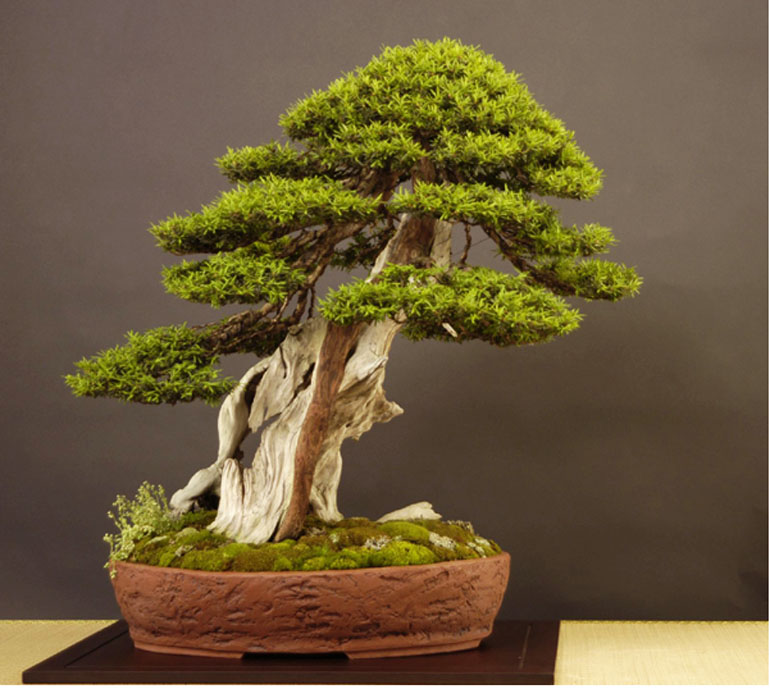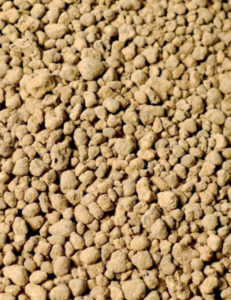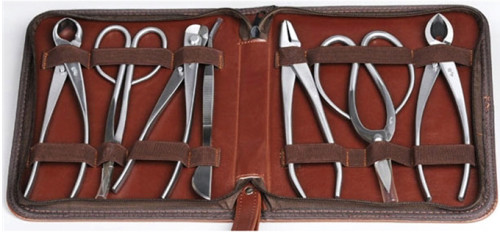
This old Japanese yew (Taxus cuspidata) belongs to Mauro Stemberger. The color coordinated pot is by Petra Hahn (even the moss has reddish spots). I found the photo on The Art of Bonsai Project.
Just for the fun of it, I searched our archives for the word Easter today. As you might suspect, all the posts with Cotoneaster came up. No surprise there. But so did several others, including this one (from December, 2015).
My humble apologies… I didn’t realize that it’s tax time until after I dug up this old ‘Taxus’ post. Once I did realize, I couldn’t resist the title.
Continued below…
20% off all Bonsai Wire
Sale Ends Monday at 11:59pm EDT
 We have two large Bonsai Wire shipments on the way
We have two large Bonsai Wire shipments on the way
and more in the works
Our Solution? A large Sale to make space
Sale Ends Monday at 11:59pm EDT
This powerful and famous Yew by Bonsai Master Masahiko Kimura is in a class by itself. It's from our book The Magician, the Bonsai Art of Kimura 2.
One of the great things about Yews is they grow almost everywhere. Half the landscapes here in the Eastern U.S. sport a yew or two. For some of us, it’s possible to find good ones for bonsai in our own front yards (suburban Yamadori). Or someone else’s front yard. Just don’t get caught (just kidding, I hope you do get caught).
Every time I open Bonsai Today issue 106 and lay my eyes on this wicked old English yew (Taxus baccata), my mind does a little double take. It may not look exactly like anything you'll see in nature, but it certainly jumps off the page. The extensive and very time consuming carving (as well as the trimming and wiring) is by Kevin Willson. Photo by Simon Carr.
This photo from the 3rd U.S. National Bonsai Exhibition Album is a good example of the quality photos you’ll find in all of the U.S. National Bonsai Exhibition Albums. The tree is an old Japanese yew from the Pacific Bonsai Museum.
Our Spring Bonsai Soil
is all bagged & ready to ship
 Akadama Japanese Bonsai Soil
Akadama Japanese Bonsai Soil
Kamuna Japanese Azalea Soil
Lava & Pumice for mixing your own
& a Japanese favorite…
Aoki blended volcanic soils
This muscular Japanese yew resides at the Omiya Bonsai Art Museum in Saitama, Japan, along with numerous other top tier bonsai. The pot looks like it could be Tokoname. Though you can't see the back, it's possible that the single live vein in the front supports all of the foliage in the tree's substantial crown.
Rugged tree, rugged pot. It's hard to say if the two trunks share a single root system, but my guess is they do. Or maybe there's only one trunk with a large hole in the center. It's another Japanese yew. It belongs to Walter Pall. The pot is by Walter Venne. The tree was originally collected in Korea and is said to be over 100 years old.
The powerful Yew with its flowing (melting) deadwood and reddish bark belongs to Mauro Stemberger (as does the tree at the top of the post). And then there's that wonderful little piece of deadwood that's used as a companion. The pot is a Tokoname.
